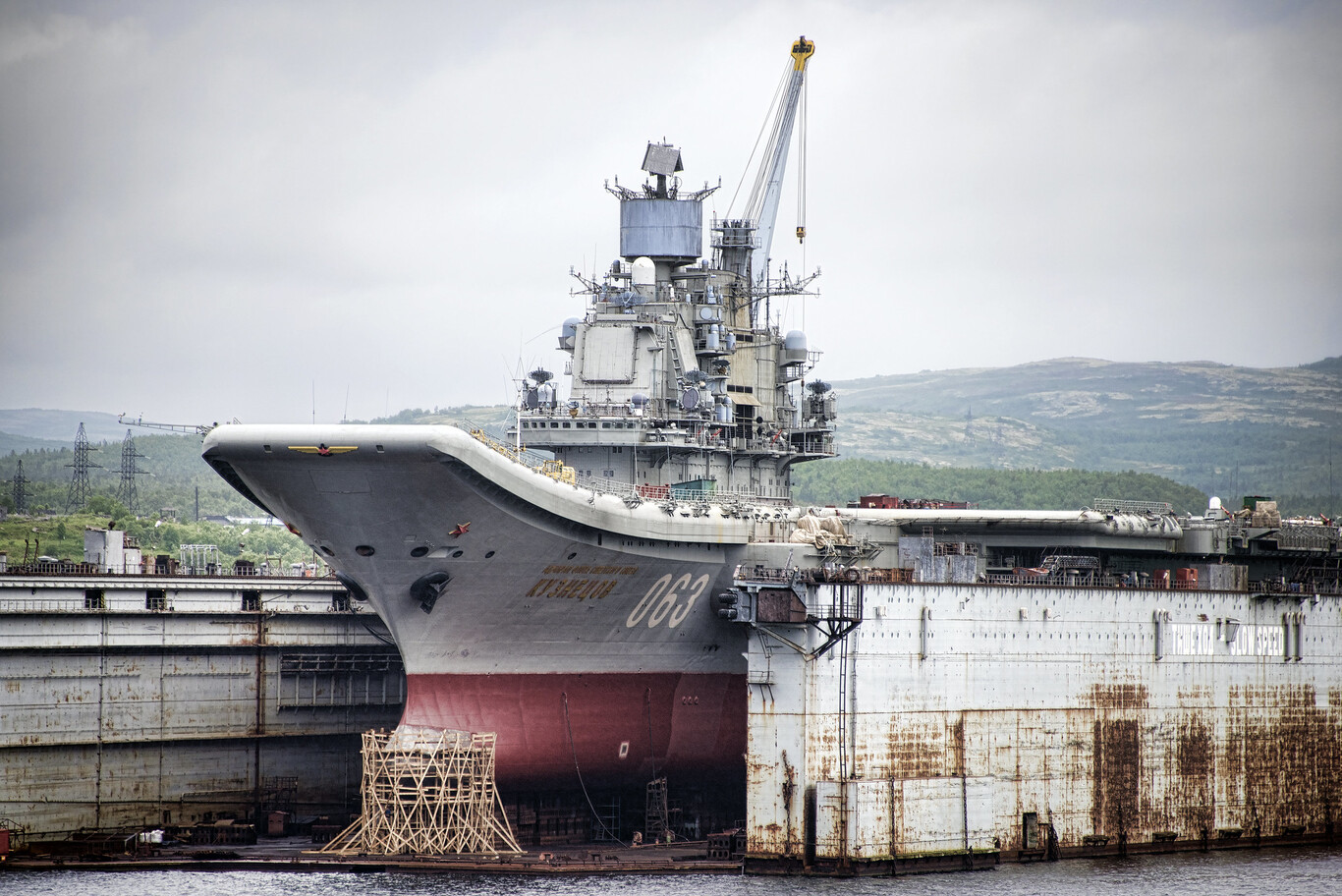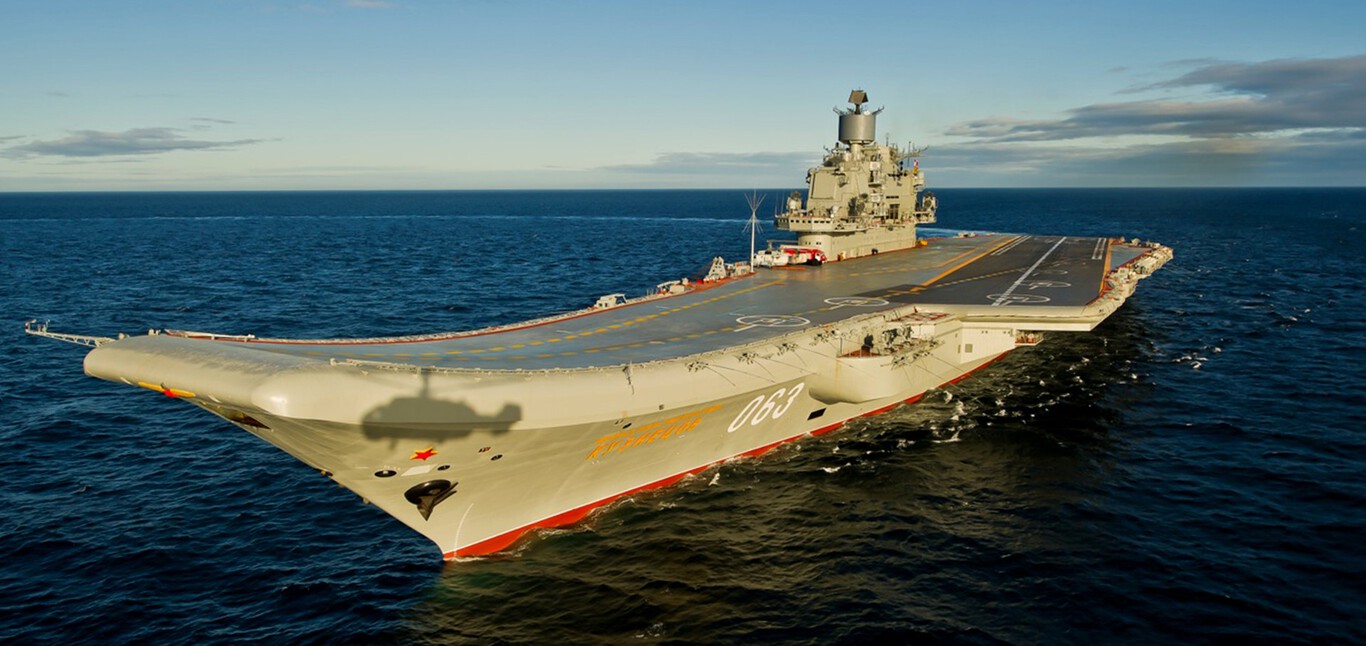
Russia’s only aircraft carrier, Admiral Kuznetsov, should be a symbol of the military might of the world’s greatest country. Far from being a deterrent tool, however, like the nuclear arsenal of 1,600 strategic weapons or “Kinzhal” hypersonic missiles, she is a ship that seems to have fallen out of favor. Design defects, dirty fuel that accuses its presence, and accidents.
Now Admiral Kuznetsov is out of commission. She waits patiently at the 35th Repair Shipyard in Murmansk, in northwest Russia, where she will undergo a major upgrade consisting of various repairs, replacement of her boilers, and part of her equipment. If all goes well he will sail again in 2024, but why did he end up there and has such a bad reputation?
Admiral Kuznetsov, the “cursed” ship
The aircraft carrier was built in the former Ukrainian SSR during the 1980s. It was christened in 1985 but entered service in 1995 when the fall of the Soviet Union occurred amid final tests and subsequent certification. In August 1991, independent Ukraine claimed ownership of the carrier, but she remained in the Soviet fleet and later became part of Russia.

With an approximate full load displacement of 66,600 tons, a length of 270 meters, 30mm AK-630 rotary autocannons, Kashtan CIWS air defense systems, P-700 Granit cruise missiles, 3K95 Kinzhal missiles, UDAV-1 rocket launcher, Among other weapons, Admiral Kuznetsov is tasked with supporting and defending strategic submarines, surface ships, and naval missile carrier aircraft.
It has been designed to house 24 aircraft, mainly Su-33 Flanker D fighters (they can take off without catapults) and MiG-29, and Kamov Ka-27 helicopters. Although, it usually sails with fewer units, about ten Su-33 and five MiG-29. It has 3 launch pads without catapults, with 3 air deflectors that lift off the deck. For example, the American aircraft carrier USS Gerald R. Ford (CVN 78) can carry some 75 aircraft.
The aircraft carrier has been described as “The ship of shame” by the former British Defense Secretary, Michael Fallon.
Unlike most Western military vessels, which are powered by gas turbines or nuclear reactors, Admiral Kuznetsov is powered by conventional propulsion; what is unconventional is the fuel it uses. This is Mazut, a low-quality tarry fuel oil used in power plants. Due to its characteristics, it is difficult to obtain in countries with strict environmental regulations, so its production and use are limited almost exclusively to Russia, Kazakhstan, Azerbaijan, and Turkmenistan.
But not all Russian ships are powered by Mazut. In addition to their aircraft carrier, the Sovremenny-class destroyers sail on this fuel considered “dirty oil.” In general, this type of boat leaves a trail of black smoke in its wake, which usually arouses some people’s curiosity. Former British Defense Secretary Michael Fallon described the carrier as “the ship of shame” when she sailed off the British coast in 2017.
Admiral Kuznetsov has also been described as “faint-hearted” due to low shipbuilding standards. According to an article published on the Russian site VZ, those responsible for the project made many mistakes, including installing poor-quality pipes in the boilers, which limited their capacity.
Admiral Kuznetsov was a “faint-hearted” aircraft carrier.
However, these are just some reasons Admiral Kuznetsov has such a bad reputation. In 2009, Russia sent it along with other ships to sail around different parts of the world to demonstrate its military resurgence. Still, when they were at the Aksaz naval base of the Turkish navy on the southeast coast of the sea Aegean, the aircraft carrier caught fire due to an electrical failure, and one sailor was killed.
In 2012, while sailing off the coast of France, the carrier suffered a propulsion system failure, forcing Moscow to send a tugboat to rescue it. When nothing could worsen, in 2016, she lost two planes due to a series of problems in the arrest system. On November 14 that year, a MiG-29K crashed while attempting to land. Two weeks later, on December 5, Su-33 fell into the ocean.
After this misfortune, the carrier returned to Russia for maintenance, but the outlook did not improve. In 2019 a crane fell on the ship during repair work, opening a hole in the deck. The accident occurred after the interruption of the electrical supply of the floating dry dock where she was located. The pumps stopped working, and the structure, known as PD-50, sank. Of course, it was not just another structure; it was the largest Russian floating dock and one of the largest in the world.
But Admiral Kuznetsov’s losing streak also hit this structure. After the accident, the aircraft carrier managed to stay afloat, but the floating dock began to submerge slowly. Unfortunately, the shipyard workers could not move it, which is currently submerged at about 60 meters. This was a direct blow to Russia, which used these facilities to maintain and repair its largest warships.
Later that same year, the carrier caught fire again. On this occasion while a team of welders worked on the first power unit. According to TASS, the area affected by smoke and fire covered 500 square meters. One person died, and a dozen were injured. As mentioned above, it sits in another shipyard awaiting various repairs and a major upgrade. According to Reuters, the ship could return to service in 2024 at the earliest.

Sharlene Meriel is an avid gamer with a knack for technology. He has been writing about the latest technologies for the past 5 years. His contribution in technology journalism has been noteworthy. He is also a day trader with interest in the Forex market.











